Water passes into a cell due to
Op
DPD
turgor pressure
diffusion.
The correct Answer is:B
To answer the question "Water passes into a cell due to", we need to analyze the options provided and understand the concepts related to water movement in plant cells.
1. Understanding Water Movement: Water movement into and out of cells is primarily influenced by water potential and diffusion pressure deficit (DPD).
2. Defining Key Terms:
- Osmotic Potential (OP): This refers to the potential of water to move across a semipermeable membrane due to solute concentration.
- Diffusion Pressure Deficit (DPD): This is the difference between the diffusion pressure of pure water and the diffusion pressure of the solution. It indicates the tendency of water to move into a cell.
- Turgor Pressure: This is the pressure exerted by the fluid (water) inside the central vacuole against the cell wall, which helps maintain cell structure.
- Diffusion: This is the passive movement of molecules from an area of higher concentration to an area of lower concentration.
3. Analyzing the Options:
- A. OP (Osmotic Potential): While osmotic potential plays a role in water movement, it is not the direct cause of water entering the cell.
- B. DPD (Diffusion Pressure Deficit): This is a key factor in water movement. Water moves from areas of lower DPD (where there is less solute and more water) to areas of higher DPD (where there is more solute and less water).
- C. Turgor Pressure: This is a result of water entering the cell, not a cause of water entering the cell.
- D. Diffusion: While diffusion is a process that can involve water movement, it does not specifically explain the mechanism of water entering a cell in the context of DPD.
4. Conclusion: The primary reason water passes into a cell is due to the Diffusion Pressure Deficit (DPD). Water moves from areas of lower DPD to areas of higher DPD, which drives the movement of water into the cell.
Final Answer:
Water passes into a cell due to B. DPD (Diffusion Pressure Deficit).
---
- Osmotic Potential (OP): This refers to the potential of water to move across a semipermeable membrane due to solute concentration.
- Diffusion Pressure Deficit (DPD): This is the difference between the diffusion pressure of pure water and the diffusion pressure of the solution. It indicates the tendency of water to move into a cell.
- Turgor Pressure: This is the pressure exerted by the fluid (water) inside the central vacuole against the cell wall, which helps maintain cell structure.
- Diffusion: This is the passive movement of molecules from an area of higher concentration to an area of lower concentration.
- A. OP (Osmotic Potential): While osmotic potential plays a role in water movement, it is not the direct cause of water entering the cell.
- B. DPD (Diffusion Pressure Deficit): This is a key factor in water movement. Water moves from areas of lower DPD (where there is less solute and more water) to areas of higher DPD (where there is more solute and less water).
- C. Turgor Pressure: This is a result of water entering the cell, not a cause of water entering the cell.
- D. Diffusion: While diffusion is a process that can involve water movement, it does not specifically explain the mechanism of water entering a cell in the context of DPD.
Water passes into a cell due to B. DPD (Diffusion Pressure Deficit).
Topper's Solved these Questions
- BOOK - NCERT FINGERTPS ENGLISHCHAPTER - TRANSPORT IN PLANTSEXERCISE - Long Distance Transport of Water12videos
TRANSPORT IN PLANTS
- BOOK - NCERT FINGERTPS ENGLISHCHAPTER - TRANSPORT IN PLANTSEXERCISE - Transpiration13videos
TRANSPORT IN PLANTS
- BOOK - NCERT FINGERTPS ENGLISHCHAPTER - TRANSPORT IN PLANTSEXERCISE - Transport In Plants119videos
TRANSPORT IN PLANTS
- BOOK - NCERT FINGERTPS ENGLISHCHAPTER - THE LIVING WORLDEXERCISE - The Living World130videos
THE LIVING WORLD
Similar Questions
Knowledge Check
- Question 1 - Select One
Study the diagram of plant cell where water passes through the cell wall and answer the questions that follow :
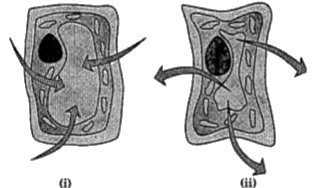
Match the phenomenon in absorption and conduction of water and minerals:
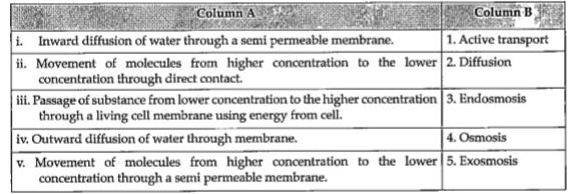 Ai-2,ii-3,iii-5,iv-1,v-4Bi-3,ii-2,iii-1,iv-5,v-4Ci-3,ii-4,iii-2,iv-5,v-1Di-3,ii-2,iii-1,iv-4,v-5
Ai-2,ii-3,iii-5,iv-1,v-4Bi-3,ii-2,iii-1,iv-5,v-4Ci-3,ii-4,iii-2,iv-5,v-1Di-3,ii-2,iii-1,iv-4,v-5 - Question 2 - Select One
Study the diagram of plant cell where water passes through the cell wall and answer the questions that follow :
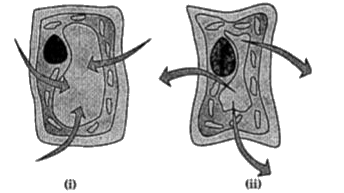
Identify the figure (ii).AFlaccid cellBTurgid cellCPlasmolysed cellDNone of these - Question 3 - Select One
Study the diagram of plant cell where water passes through the cell wall and answer the questions that follow :
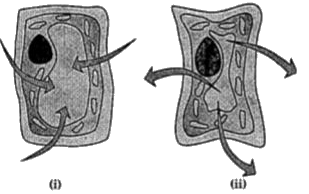
Identify the figure (i)AFlaccid cellBTurgid cellCPlasmolysed cellDNone of these
When water enters a plant cell due to diffusion causing a pressure built against the cell wall makes it turgid. This increase the
View SolutionThe pressure that prevails in cell due to number of substances dissolved in cell sap is
View SolutionThe water rises in staw due to suction , it is due to
View SolutionStudy the diagram of plant cell where water passes through the cell wall and answer the questions that follow :

Water regulation within the plant cell occurs through the process:View SolutionStudy the diagram of plant cell where water passes through the cell wall and answer the questions that follow :
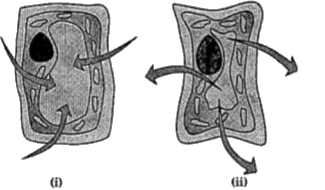
Marine fish when placed in tap water bursts because of:View Solution

